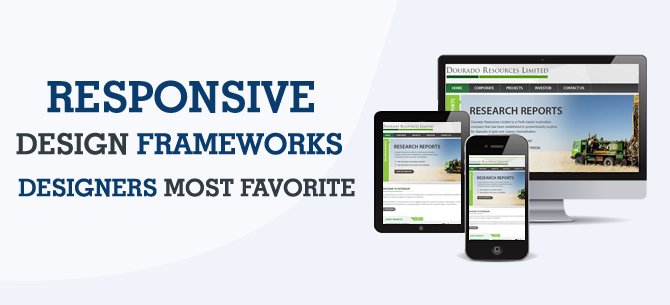Our Offices
USA OFFICE
937, Shore Point Court, # G313,
Alameda - 94501, California, USA.
INDIA OFFICE
C - 81C, Sector - 8,
Noida 201301, UP


Even without statistical proofs, website designers can definitively conclude that mobile devices are the next great frontier of Internet browsing. As such, developing a business website should always take into consideration creating a responsive website design.
That being said, building a responsive website from scratch is not a walk in the park and even the most experienced web designing companies may not readily be able to create a responsive web platform on their own. Luckily, there are pre-existing responsive design frameworks that are readily available for use.
Enumerated below are some of the most widely used responsive design frameworks website designers all over the world are using.
Bootstrap
Bootstrap is arguably the most popular framework in creating a responsive website design. Co-created by former Twitter web platform designer Mark Otto, Bootstrap is fully customizable and packs a number of features or components including navigation, typography, form controls, and a responsive grid with 12 columns JavaScript plugins just to name a few.
Foundation
Whether its claim of being “the most advanced responsive front-end framework in the world” is true or not, Foundation is definitely a hit among responsive website designers. Like bootstrap, Foundation also has a 12-colum adaptable grid that allows designers to create sophisticated layouts without the need to create custom elements from scratch. The team behind Foundation recognizes that the process of developing a business website involves several revisions and modifications which is why this framework allows for expedient prototyping to let website designers change and manipulate design elements conveniently. Further, websites created using Foundation is compatible with all devices, screen resolutions and screen sizes.
320 and Up
Web designing companies created responsive web design to fit websites into small screens. Seemingly contradicting this is the out-of-the-box responsive design boilerplate 320 and Up. It’s a responsive web design framework that takes into consideration “tiny screens first” and bigger screen sizes are the “responsive versions.” 320 and Up’s toolkit is streamlined and contains only usable files and styles. It also has the scripts LESS and Sass, but designers who are more comfortable using CSS may also do so.
Gumby
Whether this responsive web design framework takes inspiration from the clay humanoid character Gumby or not, it definitely is as pliable and adaptable as the character it takes its name after from. Web designing companies recommend this for designers who are not yet that familiar with creating a responsive website design as it is lightweight and pretty straightforward. It only features a User Interface andPSDkit so you can create site mockups using the method you’re used to. Similar to Foundation, Gumby allows for fast prototyping.
Website Designers Don’t Need to Scratch from Square One
Developing a business website with responsive design in mind is no longer an option but a necessity. For designers, using these platforms will definitely make the job easier and even enjoyable.
If you’ve tried out designing a site using the platforms above, please let me know your experience and do share other platforms that you found really useful.
Subscription Implies Consent To Our privacy Policy
7 Reasons Why Internet Marketing Is Important For Your Business
The 10 Advantages of Using WordPress for Developing Business Website